Photonic
Harmless

Posts: 36
Registered: 29-5-2016
Member Is Offline
Mood: No Mood
|
|
Copper Oxychloride Identification
I have been unable to positively identify a copper compound I have created. My theory is that it is copper oxychloride, however, I would like someone
to confirm. Further, I am unable to find any tests for determination, and have been unable to locate any sources beyond "Handbook of copper compounds
and applications - H. Wayne Richardson" referenced in the Wikipedia Article, and no significant references were found on Pubchem.
The compound was synthesized via copper metal in HCl (aqueous) conditions. Air was bubbled through the solution for approximately 20 days, and then
left to sit approximately 2 years in air before processing. At the end of the experiment I was left with insoluble "copper oxychloride", and copper
chloride. 75% of the material by volume was the insoluble material.
The products were then filtered to separate the solid from the liquid, and they were dried separately.
Picture descriptions:
"Wet before hotplate" - This is the solid material before it has been dried on the hotplate. It is a blue-green color reminiscent of copper carbonate.
It appears to be soluble in aqueous HCl, and insoluble in water alone. No gas evolution was observed.
"Hotplate dry before crucible" - This is the solid after is had been dried on a hotplate ~310-340C for ~1 hour
"Crucible Before" - This is the sample that went in at ~600-700C for 30 mins yielding what I believe is copper oxide. (See vial photo)
"Crucible After" - This is the sample that was placed in the furnace at 450C for approximately 45 mins. It was checked periodically and removed once
all of the material changed colors to the first noticeable color change. This looks very similar to the copper chloride but the color is observably
different.
"Dissolved" - The test tube on the left was dissolved a small amount from the water soluble "After filtration, water soluble, dried" sample. The test
tube on the right had a sample of the crucible after 450C placed in it. Both test tubes were heated until warm.
"After Filtration, Water Soluble" - This is what I believe to be the copper chloride.
Finally, What is there to do with it?
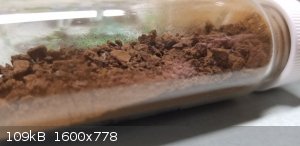 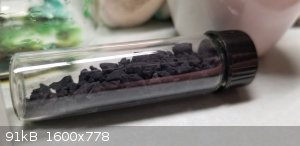 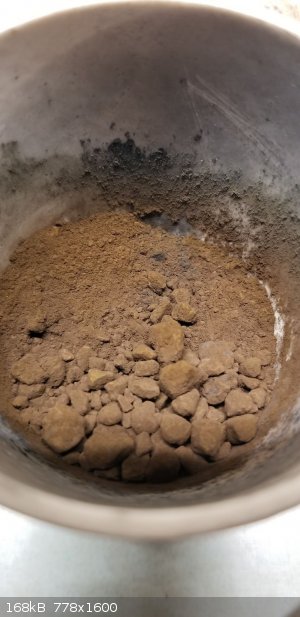 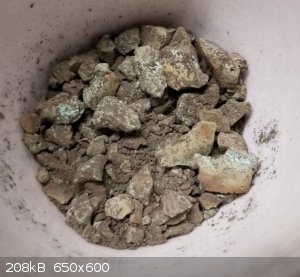 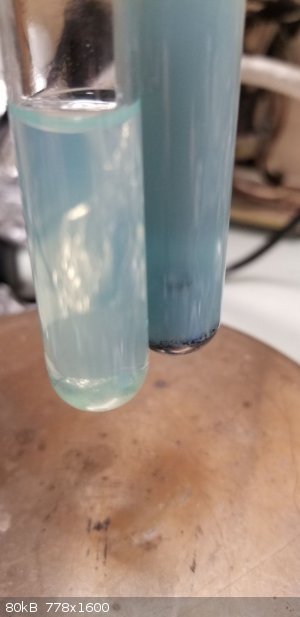 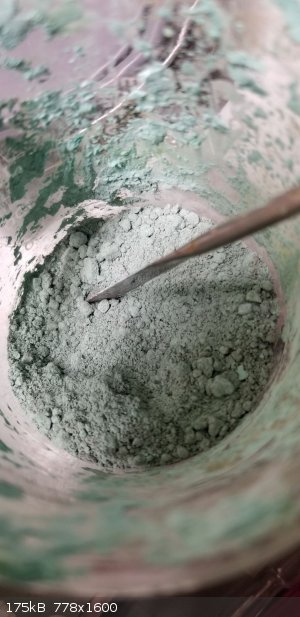 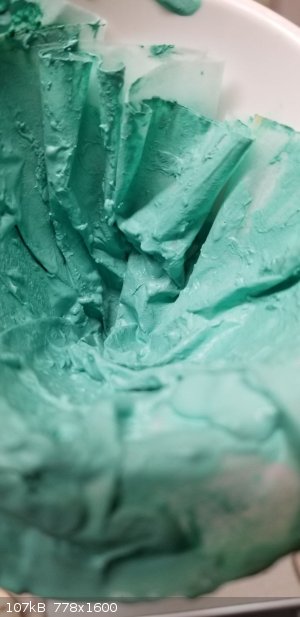
|
|
|
wg48
National Hazard
   
Posts: 821
Registered: 21-11-2015
Member Is Offline
Mood: No Mood
|
|
There are probably a variety of tests to identify copper ox chloride but they probably require reagents or equipment you don’t have.
Given how the insoluble compound was made from copper metal HCl and air, its an insoluble green compound, it is decomposed to a vaguely similar
looking material to copper oxide, I would suggest it probably (>75% probability) is copper oxychloride. I would have expected the oxide to be much
darker.
If you have electronic scale with sufficiently accuracy and resolution you could the dry a sample of the precipitate to a constant weight at say
120C (not any higher as it may decompose). Then heat the sample to the expected decomposition temperature of oxychloride and reweigh. The ratio of the
two reading should help you identify the compound. The problem with this is there are apparently different formula for the oxychloride probably
because there are different oxychorides.
PS your descriptions of the pics seems to be mixed up. I assumed the last pic is the oxychloride and if the black material is the copper oxide from
the decomposition of the oxychloride that is the correct colour,
[Edited on 3-9-2018 by wg48]
Borosilicate glass:
Good temperature resistance and good thermal shock resistance but finite.
For normal, standard service typically 200-230°C, for short-term (minutes) service max 400°C
Maximum thermal shock resistance is 160°C
|
|
|
symboom
International Hazard
    
Posts: 1143
Registered: 11-11-2010
Location: Wrongplanet
Member Is Offline
Mood: Doing science while it is still legal since 2010
|
|
Doesnt hypochlorite and copper sulfate for copper oxychloride
I have done this reaction and i get an insouble green precipitate
|
|
|
AJKOER
Radically Dubious
    
Posts: 3026
Registered: 7-5-2011
Member Is Offline
Mood: No Mood
|
|
If I have a Cu(OH)2.xCuCl2 salt, I could dissolved it in concentrated ammonia. Then, evaporate the solution recovering the mixed salts. Heat the dry
salts in a bell jar to decomposition and collect the NH4Cl on the sides of the vessel. The NH4Cl indicates the moles of chloride and the total weight
of residual CuO indicates the moles of copper present.
This, of course, is much more easily said that can be executed in practice.
I probably would sublime a known quantity of NH4Cl in a bell jar and devise an estimation method to actually reproduce the known quantity of ammonium
chloride.
[Edited on 4-9-2018 by AJKOER]
|
|
|